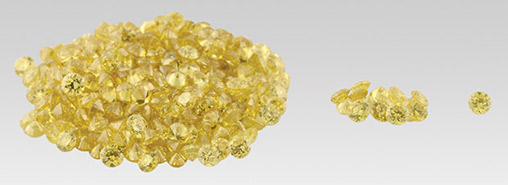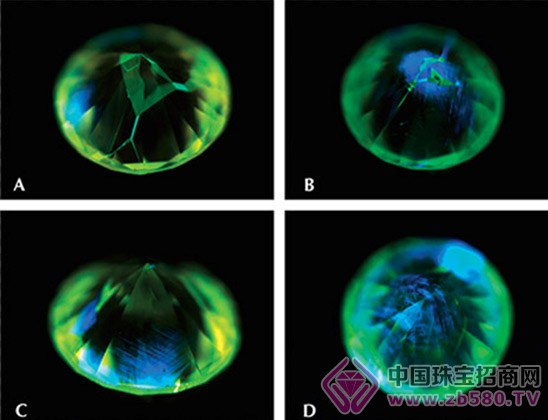The processing and synthesis of diamonds has undergone an important development over the past decade. During this period, more and more processed and synthetic rice diamonds were mixed in natural diamonds for sale because it is less feasible to test each of the millet grains in a pack, so most small yellow diamonds are traded. It is not necessary to send each pellet to the laboratory for identification. Recently, GIA New York Labs received two packs of rice-size yellow diamonds that were screened for natural, synthetic or processing. The test results may have important implications for future trading of rice yellow diamonds. A round diamond with a size of 0.02-0.03ct and a total of 359 capsules was sent to the laboratory for testing. The appearance of this batch of rice diamonds is extremely consistent (figure), yellow is rich and the clarity is good. Based on the spectral analysis data, it is found that the color of each sample is related to the solitary nitrogen in the diamond. According to the gemological characteristics, the infrared absorption spectrum characteristics and the characteristics of the DiamondView fluorescence image, it can be determined that 344 of them are natural genetic diamonds, and 14 of them are high temperature and high pressure. Synthetic diamonds, 1 capsule of HPHT treated natural diamonds (figure). Among the 14 HPHT synthetic diamonds, 8 of them are mainly type A nitrogen, and contain a small amount of solitary nitrogen atoms, and the other 6 are mainly nitrogen, and the nitrogen content of type A is negligible. All synthetic diamonds contain a diffuse, point-like inclusion, which is one of the characteristic inclusions of HPHT synthetic diamonds. Six of them can be observed under the DiamondView to observe the growth partitioning of HPHT synthetic diamonds. High levels of A-type nitrogen in synthetic diamonds indicate higher synthesis temperatures and may experience multiple high temperature processes. In order to verify the prevalence of synthetic and treated diamonds in bulk rice diamonds, we tested another 525 diamonds and reached similar conclusions. One of them is HPHT-treated natural diamonds and 10 of them are HPHT synthetic diamonds. These 10 diamonds, regardless of their gemological characteristics, or their spectral and fluorescent characteristics, are consistent with the characteristics of synthetic diamonds. The remaining 514 are natural untreated diamonds. . Some of the DiamondView luminescence images in these synthetic diamonds can be observed in the growth partitioning characteristics of typical HPHT synthetic diamonds, but most are similar to the DiamondView luminescence features of natural diamonds. This phenomenon tells us that when distinguishing natural jade synthetic diamonds, especially rice diamonds, it is one-sided to rely solely on the characteristics of DiamondView illuminating images. More importantly, it is necessary to make final conclusions based on its infrared spectral characteristics. The importance of infrared spectroscopy in diamond identification is further emphasized. This study shows that there are often synthetic and processed diamonds mixed in the rice yellow diamonds traded on the market. In order to ensure the correctness of the identification results, the jewelry identification laboratory needs to strengthen the identification of diamonds. The most effective and reliable method is to use infrared. Spectral technology, DiamondView illuminating images and other spectroscopy techniques are combined to complete the analysis. Through the analysis of all 883 diamonds, we finally determined that 857 capsules were natural diamonds (87.1%), 24 capsules were HPHT synthetic diamonds (2.7%), and 2 capsules were HPHT-treated natural diamonds (0.2%). Figure 3: The left side is a natural diamond. In the picture, there are 14 HPHT synthetic diamonds. On the right, there are 2 HPHT-treated natural diamonds. Their colors are the same and the naked eye is difficult to distinguish. Figure 4A is an image of a typical HPHT synthetic diamond viewed under DiamondView, B is a View image of a HPHT-treated diamond, and C and D are View images of an HPHT synthetic diamond with insignificant features. Men'S Jacket,2020 New Denim Jacket,Popular Jeans Jacket,Cotton Mens Jean Jacket Shaoxing Weihui International Trade Co.,Ltd. , https://www.weihui-fabric.com

How to identify the processed and synthesized yellow rice small diamonds
Prev Article
Parkinson's brand-name home service upstart